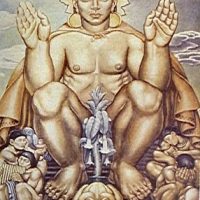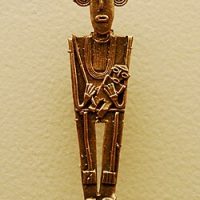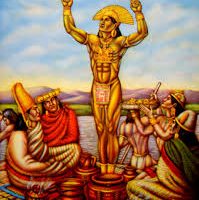Chiminigagua : The Cosmic Light of Muisca Creation
Listen
At a glance
| Description | |
|---|---|
| Origin | Muisca Mythology |
| Classification | Gods |
| Family Members | N/A |
| Region | Columbia |
| Associated With | Creation, Light |
Chiminigagua
Introduction
Chiminigagua is the supreme creator deity in the mythology of the Muisca, the indigenous civilization that once flourished across the highlands of present-day Colombia. Revered as the primordial source of light and existence, Chiminigagua embodies the moment the universe shifted from darkness into illumination. Muisca tradition describes this deity not as a physical god but as an abstract cosmic principle, a self-generated force that existed before the world began and triggered creation through its radiant essence. As the origin of the sun, moon, and the natural order, Chiminigagua shaped how the Muisca understood time, morality, and the cycle of life, influencing their spiritual practices and worldview even without direct worship ceremonies dedicated to this transcendent being.
Physical Traits
Chiminigagua is not represented through statues or pictorial forms because the Muisca viewed the creator as a formless and eternal light rather than a god with human attributes. In their cosmogony, the universe existed in complete darkness until Chiminigagua released its inner brilliance. This divine act is often symbolized through the emergence of two enormous black birds, believed to be cormorant-like beings, who carried the creator’s light in their beaks. As they flew across the world, light unfolded behind them, illuminating the sky and giving shape to the cosmos. Instead of a face, limbs, or physical body, Chiminigagua is conceptualized as pure luminosity—a sacred, invisible force whose presence can be understood only through the harmony of the natural world and the celestial order it set in motion.
Family
Chiminigagua exists without parents or consorts, standing alone at the origin of Muisca cosmology. Yet from its creative essence emerged the other major deities who govern the natural cycles essential to human survival. Among its most important creations are Sué, the Sun god, whose warm radiance sustains agriculture and marks the passage of days, and Chía, the Moon goddess, whose phases structure the calendar and influence fertility. Some traditions also connect Cuchavira, the rainbow deity associated with renewal after storms, to Chiminigagua’s generative light. These divine beings were central to Muisca religious life, acting as intermediaries who expressed aspects of the creator’s power. Although Chiminigagua remained distant and abstract, the rest of the pantheon formed a spiritual family through which the Muisca related to the forces of nature.
Other names
The name Chiminigagua appears in variations such as Chiminichagua and Chimichagua, largely due to differing colonial spellings of the Chibcha language. Despite these variants, the meaning remains consistent across sources: the great essence of light or the supreme illuminating force. These names appear in early Spanish chronicles, which preserved much of the information about Muisca religious beliefs after the disruption caused by colonization. Today, the name Chiminigagua is the standardized version used in academic research and indigenous cultural revitalization movements, reflecting both linguistic accuracy and historical continuity.
Powers and Abilities
Chiminigagua’s powers define the structure of the universe and the order within it. The deity’s most significant act is the generation of light from its own being, transforming an unformed void into a world where life could emerge. By sending forth the celestial birds that spread illumination, Chiminigagua established the sun, moon, and stars, which became the foundations of agriculture, timekeeping, and spiritual symbolism for the Muisca. The creator’s powers are not linked to intervention in daily affairs but to the initial act of shaping reality. As a benevolent force, Chiminigagua represents moral goodness and cosmic balance. Its influence continues through the actions of other gods, especially Bochica, a civilizing hero often described as its messenger, who taught society essential skills and ethical principles. Through these intermediaries, Chiminigagua remains a guiding presence in the order of nature and human life.
Modern Day Influence
Although direct worship of Chiminigagua faded after Spanish colonization, the deity remains an important cultural symbol for the descendants of the Muisca and for Colombian heritage more broadly. Modern indigenous organizations reference Chiminigagua as a representation of resilience, ancestral knowledge, and spiritual connection to the land. Museums, including Bogotá’s Museo del Oro, highlight Muisca cosmology to educate future generations about the depth of pre-Columbian belief systems. Artists and writers draw inspiration from Chiminigagua’s creation myth to explore themes of light, identity, and the origins of existence. Environmental movements also connect with this deity’s symbolic association with natural harmony, promoting ecological consciousness grounded in indigenous wisdom. As scholarship on the Muisca continues to grow, Chiminigagua stands as a powerful emblem of a sophisticated worldview that valued balance, cosmic order, and the sacredness of life.
Related Images
Source
Autoridad Nacional de Turismo de Colombia. (2023). Muisca culture and mythology. https://www.colombia.travel/en/culture/muisca-mythology
De Castellanos, J. (1605). Elegías de varones ilustres de Indias. Biblioteca Nacional de Colombia.
López, M. G. (2024). The Muisca and their gods: Light, fertility, and creation. Journal of Andean Studies, 58(1), 102-121.
Simón, P. (1626). Noticias historiales de las conquistas de Tierra Firme en las Indias occidentales. Biblioteca Nacional.
Urbina, C., & Vega, R. (2022). The cosmic dualism of the Muisca people. Indigenous Mythologies Quarterly, 14(2), 45-66.
Wikipedia contributors. (2016, April 28). Chiminigagua. Wikipedia. https://en.wikipedia.org/wiki/Chiminigagua
Wikipedia contributors. (2016, May 3). Muisca religion. Wikipedia. https://en.wikipedia.org/wiki/Muisca_religion
Gods and Monsters. (2025, July 31). Chiminigagua: The Muisca Creator God of Light and Mystery. https://godsandmonsters.info/colombian-mythology
Frequently Asked Questions
Who is Chiminigagua in Muisca mythology?
Chiminigagua is the supreme creator god and the primordial source of light in the Muisca belief system, responsible for initiating the creation of the universe.
How did Chiminigagua create the world?
According to Muisca cosmology, Chiminigagua released radiant light carried by two giant black birds, illuminating the cosmos and forming the sun, moon, and stars.
Is Chiminigagua depicted in physical form?
No. Chiminigagua is represented as a formless cosmic light or essence rather than an anthropomorphic deity.
What gods did Chiminigagua create?
Chiminigagua is believed to have produced Sué (the Sun), Chía (the Moon), and other celestial beings that regulate natural cycles.
Does Chiminigagua influence modern Colombian culture?
Yes. Chiminigagua remains a symbol of indigenous identity, environmental harmony, and cultural revival within contemporary Colombian society.









